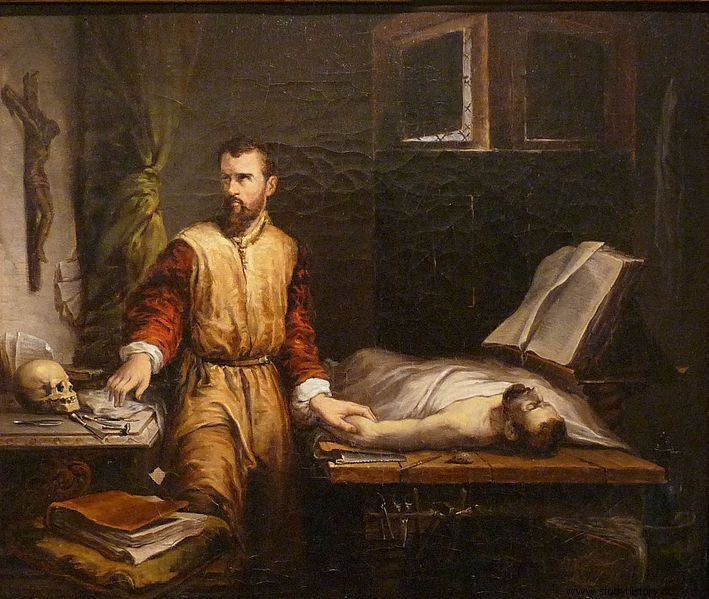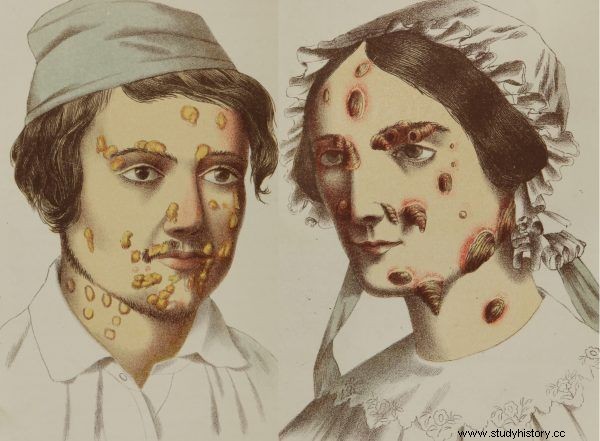Torture-like therapies, international accusations and big taboos:this is the story of the acquaintance of a man with syphilis.
Historians argue about the origin of the queen of venereal diseases on the European continent. Some believe that Treponema pallidum spirochetes came "in our direction" with the seafarers visiting America under the leadership of Columbus. Others, meanwhile, argue that syphilis had previously existed in a milder form in Europe, but by the end of the 15th century something triggered a sudden epidemic spike in the number of cases. The first recorded case in Poland dates back to 1495:the shoemaker's wife had contracted the disease during ... his pilgrimage to Rome.
The real cause of the disease, a mobile and elusive bacterium, was not identified until 1905. German scientists Fritz Schaudinn and Erich Hoffmann succeeded in isolating the spirochetes extracted in a clot from the vagina of a patient suffering from second-degree syphilis. Scientists had the more difficult task as Treponema pallidum could not be grown on nutrients in the laboratory. However, researchers - palaeopathologists trying to trace the origins of the syphilis epidemic had an even more difficult task:bacteria cause changes in patients that are easy to confuse with those caused by tuberculosis, cancer or osteomyelitis. One thing is certain:syphilis has taken a huge toll over the past centuries, and unfortunately remains a problem.
The first outbreak in the late 15th century killed around 5 million people in Europe alone! Contemporary data is also not optimistic. In 2015 alone, approximately 107,000 people died as a result of the disease. In 1990, there were almost twice as many. Both today and in past centuries, the main problem with syphilis and its diagnosis is the taboo surrounding the ailment and the fear of criticism from society . Fortunately, modern methods of treatment with antibiotics are effective and relatively safe for the patient ... but it was not always so!
Mercury time
Ambroise Paré went down in the history of medicine with golden letters. He not only criticized the deadly painful methods of cauterizing wounds with hot iron or boiling oil, but also invented surgical forceps to compress blood vessels during amputation. He promoted modern methods of treating diseases and injuries of the skeletal system, and also developed obstetrics ... But surely no one would like to find him with syphilis!
One of the symptoms of the disease is lumpy changes in the bones. Paré recommended treating them by cutting the muscles and rubbing the deadly mercury directly onto the affected parts of the patient's skeleton. Needless to say, in the 16th century (when Paré lived and worked) there was no effective anesthesia ...
It seems, however, that Paré was quite humane compared to other doctors. Syphilis ulcers were often burned out simply with hot iron, which of course could only lead to secondary infections. The beloved mercury was also used in various ways - for example, in the form of an ointment, mixed with patina, cinnabar, rust or turpentine, as well as powdered earthworms and lard. Effect? Rather meager. Therefore, it went even further:the sick were placed in tents where mercury, arsenic, antimony and lead were evaporated. Fact - if someone survived the procedure, no bacteria wanted to live inside their body anymore. However, this did not change the fact that the metal vapors caused tooth loss, severe burns to the throat and lungs, and permanent brain damage.

Ambroise Paré proposed treating syphilis with mercury
Among the methods mentioned above, rubbing with powdered bark or ointment with guaiac wood resin and wrapping patients in thick layers of material seems comparable to a stay in a sanatorium. However, this method was used at the earliest and was abandoned soonest. Of course, due to poor results.
Meanwhile, if someone had not yet fallen ill, and his unstoppable lust kept him from living in peace, he had at his disposal revolutionary linen bags soaked in mercury salts by Gabiel Fallopius. Interestingly, long before the etiological diagnosis of the disease was realized how it spreads, and an effective fight was started precisely through prevention. The gradual advancement in condom technology has been an alternative to plain abstinence.
Charlatans and bowel movements
In the 17th century, other ways were invented to slow and painfully exhaust patients. They were put on anti-generic underpants (i.e. rubbed with a solution of mercury from the inside), and were also subjected to anti-genital (i.e. mercury) enemas. The turn of the 17th and 18th centuries also brought a number of drugs taken orally. Patients could choose from Van Swieten's liquor, Dr. Bellet's mercury syrup, Belloste's pills, or Bru's tonic mercury biscuits.
As you can see, the choice could be somewhat tragic. Either way, the disease needed to be treated with mercury, although there were occasional objections from the medical community. So there were those who tried to treat syphilis with diarrhea. Archange Leroy published a work on laxatives in 1767, which appeared in Paris. In it, he recommended that not only syphilis be treated in this way, but all diseases in general. As he wrote:
The bloodletting is a disgusting operation. The use of leeches is one of the most dangerous inventions of mankind. Mercury is the enemy of humans ... Eating a diet is unnatural. There is only one effective remedy:purging - loosen, remove, cleanse, loosen, expel, clean, discard material that irritates and harms health ...
It is hardly surprising that his methods were not widely adopted.

The course of the disease was very unpleasant
Who will be blamed
Syphilis fell on Europe like a bolt from the blue, soon taking over Asia as well. Many saw the hand of God in the epidemic, and thus tried to find the culprit in the tragic situation. Of course, the first on the list was Christopher Columbus, who was alternately blamed and exonerated. It was about his sailors, who were to get into intimate contacts with American women and thus bring a dangerous strain of bacteria back home.
Happiness in disaster:Due to the transmission of syphilis, soldiers began to be accused of having a rich "sex life" during the wars. On the other hand, as is customary, entire nations were of course blamed for the emerging outbreaks of disease.
Syphilis occurred under many names, depending on the motherland from which he came:in Italy and Germany - as a French disease, in Russia - a Polish disease, in France - an English or Italian disease, in the Netherlands - a Spanish disease, in Turkey - a disease Christians, in Japan - Chinese disease, in China - Cantonese disease, and also differently in many regions of Europe:franca, court disease, court nickname, secret disease, attribute, pudendagra, scabies, muck, venereal disease, runny nose, love pox, sickness whores and adulterers
- writes Małgorzata Kłys in the work "With mercury (and ...) for centuries".
Meanwhile, Hieronim Fracastaro - a writer and philosopher from Italy, claimed that the appearance of syphilis was related to the unusual arrangement of the celestial bodies . Interestingly, the same scientist predicted the existence of bacteria, stating that there must be some kind of infectious vector, which he described as "tiny living and invisible particles".
Regardless of the real and imaginary reasons behind the syphilis epidemic, the problem affected everyone. He penetrated without mercy both peasant huts, royal courts and artists' studios. Among the famous infected were Stanisław Wyspiański, Kazimierz Przerwa-Tetmajer, Vincent van Gogh, Nicolai Paganini, Robert Schumann, Franz Schubert, Arthur Schopenhauer, Gustav Flaubert, Paul Gauguin, Ivan Groźny, Édouard Manet, Charles Hen Baudelaire, Guy de Maupelaire, Guy de Maupelaire or Vladimir Lenin.

"Syphilis occurred under many names, depending on the country from which he came:in Italy and Germany - as a French disease, in Russia - as a Polish disease ..."
The fall of the tyrant
Immediately after the discovery of syphilis spirochetes by Schaudinn and Hoffmann, the so-called Wasserman test was created, thanks to which it is possible to reveal the presence of bacteria in the patient's body. Soon there was also an arsenic-based bactericidal preparation called salvarsan by Paul Ehrlich. This one did not cure syphilis, but it did not seriously damage the patient's body and reduced the symptoms.
In 1928, Alexander Fleming discovered penicillin. Pharmacology and medicine took off, and syphilis has finally ceased to be an unpleasant and deadly taboo - instead it has become an unpleasant and less dangerous disease that can be treated. In 1943, the effectiveness of antibiotics in the treatment of syphilis was clinically proven. From then on, treatment is basically simple, and syphilis is no longer a lethal threat. This actually remains only in the social consciousness and in the minds of the sick themselves.
